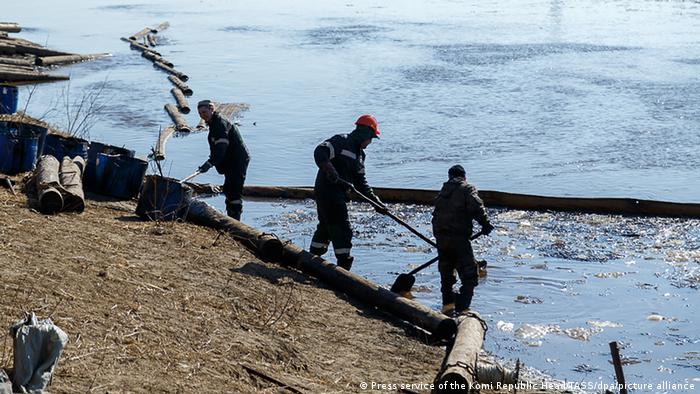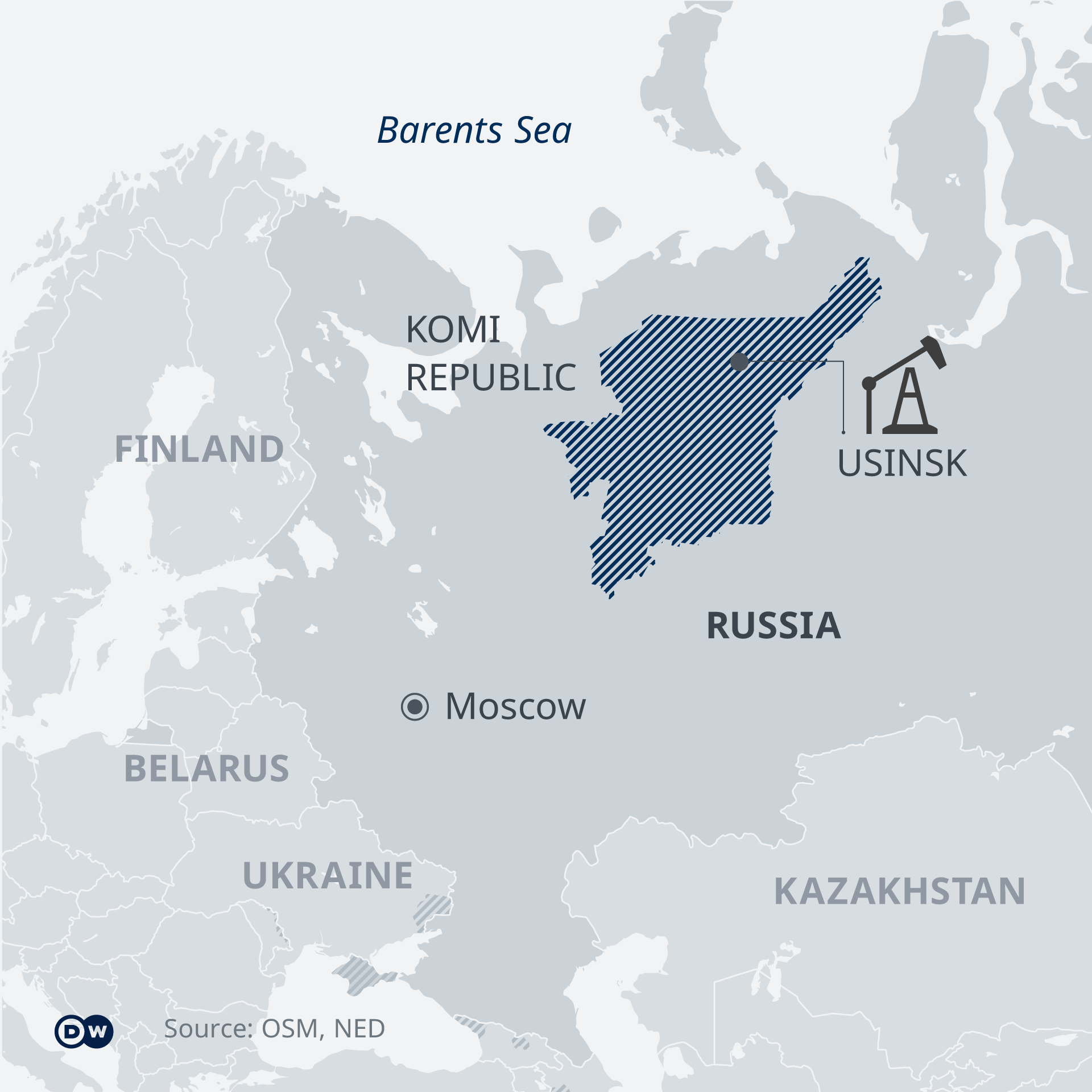A year after the huge Norilsk oil spill, there's just been another leak — one of many. The country's oil giants fear transparency. But transparency has the power to fix the leaking pipes, says Tatiana Kondratenko.

Environmental groups and journalists could help to monitor the country's huge oil industry
"Oil comes from the tap here" — that’s a phrase from my childhood in the heart of Russia’s oil region in the Komi Republic, along with memories of -40 degrees Celsius (-40 degrees Fahrenheit) in winter, the constant tapping sound of oil derricks and clouds of mosquitoes in summer.
Oil here actually doesn't exactly come from the tap — but very often it simply leaks from the pipes.
Marking Norilsk oil spill with another leak
And it's just happened again, another oil spill, almost right in time to mark the anniversary of last year's Norilsk catastrophe that contaminated the Russian Arctic with over 20,000 tons of diesel.

DW's Tatiana Kondratenko
On May 11, I got news from my hometown of Usinsk that there was oil flowing along the Kolva river where locals like to go fishing. The town's mayor declared an emergency after 90 tons of oil had leaked. Around nine tons of fuel had already reached the river before the clean-up began.
The accident originated from a Lukoil pipeline — one of the country’s oil giants and one of the biggest players in Komi.
Lukoil claims the clean-up is now almost finished. But locals who take their boats along the river share videos and photos on social media that paint a different picture: The slick is still moving further towards the Barents Sea.
Oil leaks have long been a routine for my region. The only time my sleepy town made headlines across the world was in 1994 due to the biggest oil spill on land, with a mention in the Guinness Book of World Records.
Oil spills happen frequently here, about every three to six months, but news about them usually only circulates in local groups in social networks or are covered by small independent media in the region. To soon be forgotten.
I couldn't find numbers on how many oil spills happen in Komi every year. Across Russia, over 17,000 oil leaks were recorded in 2019, mostly from pipelines, according to the Russian Ministry of Energy.
This data is based on what companies report. The full picture remains unknown. Also because it can be tricky and dangerous for outsiders to find out what's really going on.

Hands off Russia's holy cow
When I think of Russia's oil industry, Lev Tolstoy's Anna Karenina comes to mind. "All was confusion in the Oblonskys' house". Meaning: it’s very complicated.
For Russia's economy, the industry is very important — and it’s a holy cow. Many oil giants have ties with the government and are close to being untouchable.
Meanwhile, ordinary Russians working in oil production see it as a rare sector that still provides relatively good salaries and stability. The flashy images of rich Russian oil oligarchs skiing in Courchevel and hiring private jets — many of whom got their chunk of the oil cake in the 1990s when the USSR collapsed — are indicative of what was possible in Russia. Even getting your own oil derrick.
Today, an ordinary oil worker in Komi lives and works in harsh climate conditions for a monthly pay of around 200,000 rubles (€2,230; $2,720). Their colleagues in Canada or Norway probably just laugh at that.
Omnipresent fear among oil workers
Since they are lucky enough to get into the industry (often thanks to nepotism), oil workers stick to their jobs and don't risk speaking up, even though they have to deal with the problems of the corroding infrastructure on a daily basis. All my talks with local oil workers in Russia's north have always been done anonymously. Fear is omnipresent.
And when I see how reporting on Russian oil companies can backfire on journalists in the form of lawsuits and huge fines of up to 43 billion rubles (€479 million; $610 million) in one case, I'm also afraid of getting too close.
This fear creates self-censorship: I think of my relatives and potential consequences that might follow.
So, fear and lack of transparency accompany the industry. But, in many ways, it also plays against it.
Russia's oil infrastructure is massive: The network of pipelines could circle more than once around the Earth. Yet having been built in the Soviet era, it has approached its expiration date. Pipelines need costly replacements and new technologies to monitor their performance and condition.
Transparency and publicly available information on spills and accidents isn't a threat for the industry. Instead, I see it as an underestimated opportunity with the potential to upgrade Russia's oil industry and prevent environmental disasters.
Citizens, environmental groups and journalists could help to monitor a huge system that's hard to keep track of in this remote territory.
Since the country aims to stay on the fossil fuel path for now, it might even be the last resort to save the broken image of the industry — and to finally clean up the mess in the Oblonskys' house.
Russia’s many and varied environmental issues

VIDEO

VIDEO
https://tvdownloaddw-a.akamaihd.net/dwtv_video/flv/repoe/repoe20210529_gesamtHD_sd_avc.mp4
When the air stinks, drinking water is brown, and snow is black — something isn't right. People from three different regions of Russia explain the struggles they face due to pollution.Russia is facing a number of environmental issues. The air around one of its biggest landfills is thick, causing problems for residents in the area. Over in Kiselyovsk in Siberia, people are having to walk through snow so polluted by coal from a mine that it has turned black. And in the city of Krasnodar in the south, tap water often comes out brown. Who would want to live in such conditions? These three examples from different areas in Russia are all extreme in their own right, yet together they paint a picture of a country marked by pollution.
When the air stinks, drinking water is brown, and snow is black — something isn't right. People from three different regions of Russia explain the struggles they face due to pollution.Russia is facing a number of environmental issues. The air around one of its biggest landfills is thick, causing problems for residents in the area. Over in Kiselyovsk in Siberia, people are having to walk through snow so polluted by coal from a mine that it has turned black. And in the city of Krasnodar in the south, tap water often comes out brown. Who would want to live in such conditions? These three examples from different areas in Russia are all extreme in their own right, yet together they paint a picture of a country marked by pollution.
No comments:
Post a Comment